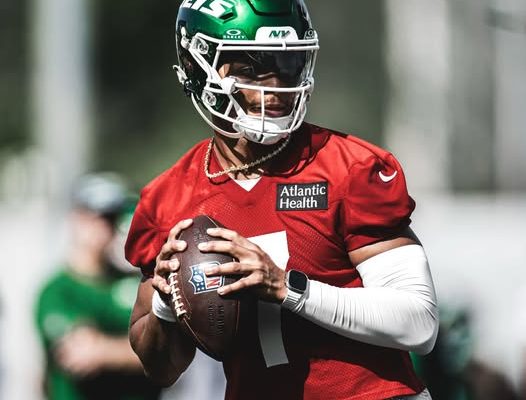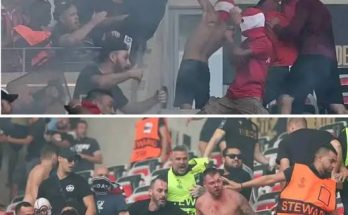The Chicago Bears and their fanbase received a collective sigh of relief after what initially appeared to be a potentially season-altering injury to quarterback Justin Fields turned out to be far less severe than feared. The update from the team’s medical staff confirmed that Fields sustained a dislocated toe on his right foot and is officially considered day-to-day. This news represents an encouraging outcome for a franchise whose fortunes in recent seasons have been inextricably linked to the performance and health of their young quarterback. Fields avoided serious structural damage, and while the injury is not insignificant, it is manageable, particularly with the benefit of the team’s top-tier medical staff and state-of-the-art rehabilitation resources.
When Fields initially went down, many around the league braced for a worst-case scenario. The quarterback was seen limping off the field, and although he tried to downplay it in post-game remarks, the concern on the sideline and from the training staff was palpable. Dislocated toes, while not uncommon in the NFL, can vary greatly in terms of severity. In some cases, such injuries can linger or require surgical correction, which could sideline a player for multiple weeks or even longer. The Bears’ quick announcement that Fields would be evaluated further offered little solace until the medical report came back with the update that there was no major ligament or tendon damage, and most importantly, no fracture.
For the Bears, this could mean the difference between salvaging momentum in what’s projected to be a competitive NFC North and descending into a tailspin early in the season. The team has heavily invested in Fields, both emotionally and strategically, framing their offensive philosophy around his dual-threat capabilities. His ability to extend plays with his legs, read the field on the move, and take advantage of mismatches in coverage is foundational to how offensive coordinator Shane Waldron has built the scheme for the 2025 season. Fields’ legs aren’t just a bonus—they’re a necessity to how the Bears function.
Fields’ trajectory over the past two seasons has been complicated. Drafted with high expectations, he initially struggled under an unstable coaching staff and behind a porous offensive line. But as the team gradually invested more in surrounding talent—through draft picks, free agency, and trades—the quarterback began to show flashes of elite-level play. While the statistical results haven’t always matched the hype, there has been no shortage of moments where Fields looked like the future of the franchise. The Bears’ front office committed to giving him at least one more full season to prove himself before evaluating longer-term plans, especially given the implications of his rookie contract and the impending decision regarding a potential fifth-year option.
The significance of the toe injury may seem small in the grander scheme, but for a quarterback like Fields, whose game relies heavily on explosive footwork, cuts, and sudden directional shifts, it could be enough to alter play-calling and his level of aggressiveness. Dislocated toes can compromise push-off ability and reduce mobility, which might lead to more conservative scrambles or even staying in the pocket more often—something Fields has historically been less comfortable with. The Bears’ medical staff will undoubtedly monitor swelling, range of motion, and pain tolerance over the next few days. Depending on how Fields responds to early treatment, there’s a chance he might suit up for practice within the week, though it’s expected he’ll be held out of full-contact reps until there’s confidence the toe is stable.
In the meantime, the Bears are preparing contingency plans. Backup quarterback Tyson Bagent, who made waves last season with his steady hand in limited appearances, has already begun taking first-team reps in practice. Bagent, an undrafted free agent out of Shepherd University, is known for his cerebral approach to the game and quick release, but lacks the dynamic athleticism and improvisational ability Fields brings to the table. If Fields is forced to miss any game action, the offensive game plan will likely undergo a temporary transformation, emphasizing timing routes, quick throws, and a more conservative approach to avoid exposing Bagent to unnecessary risk.
What’s most pressing for Chicago now is timing. The next three games on the schedule include two divisional matchups, both of which could have major playoff implications even this early in the season. A fully healthy Justin Fields gives the Bears a fighting chance against even the toughest of defenses, but a diminished version—or the absence of Fields altogether—shifts the balance significantly. If he is able to return in a limited capacity, the Bears’ coaching staff faces a difficult choice: ride with their star at less than 100% or play it safe to preserve long-term health. It’s a delicate balance that often hinges on behind-the-scenes details—player feedback, medical opinions, and competitive urgency.
Meanwhile, Fields remains upbeat. Sources close to the team describe him as already engaged in film study and rehabilitation protocols, determined not to let this injury derail what he views as a defining season. The former Ohio State standout has taken major strides in leadership, often credited by teammates and coaches alike for setting the tone in the locker room. His response to adversity has consistently leaned toward resilience rather than resignation, and that attitude will be crucial as he navigates the coming days and decisions about his readiness.
From a historical perspective, dislocated toe injuries have varied widely in impact. Turf toe, which involves ligament strain or hyperextension, is a more common and often more debilitating version. A pure dislocation without ligament rupture can actually heal faster, depending on how quickly the joint is reduced and how much inflammation results. There are notable NFL cases—like Hall of Fame quarterback Brett Favre, who played through multiple toe injuries during his career, or more recently, Patrick Mahomes battling through foot issues—where elite signal-callers managed to stay effective despite limitations. The key will be managing pain and making sure Fields doesn’t compensate in ways that increase injury risk elsewhere, such as putting undue stress on the opposite leg or altering throwing mechanics.
Beyond the physical concerns, there’s also a psychological component. Injuries—even minor ones—can lead to hesitation, especially in players who rely on fast-twitch instincts and split-second decisions. For Fields, who already carries the weight of a passionate fanbase and a franchise seeking its first elite quarterback since the days of Sid Luckman, the pressure to return quickly yet safely is immense. His ability to strike that balance will be as important as the condition of his toe itself. His maturity and evolving football IQ will be tested here, as will the team’s ability to communicate and calibrate risk.
The fanbase has already begun speculating what this could mean for Fields’ long-term future. With Chicago holding multiple future first-round picks, the temptation to explore alternatives is always there, especially in a league that never stops churning at the quarterback position. But in this moment, Fields remains the guy—and with good reason. His ceiling remains sky-high, and barring any setbacks, this injury may ultimately serve as a mere blip rather than a defining detour.
The Bears also have to think long-term. Even if Fields is capable of playing through the injury, is it worth the risk of aggravation? The NFL season is a marathon, not a sprint. And while every game matters, particularly for a team on the rise, the priority must be protecting their quarterback’s body for both the remainder of the season and his career. No injury is ever truly minor when it involves a cornerstone player, and the Bears understand that even the smallest miscalculation in recovery protocol can have outsized consequences.
For now, all eyes will be on the practice field and the injury report. Each day will offer more clues as to Fields’ readiness and how the coaching staff plans to navigate the immediate future. From the outside, it may seem like just a toe—but inside Halas Hall, it’s a major storyline that touches every facet of the organization. How they handle it could determine whether this year marks a genuine step forward or yet another frustrating chapter in the Bears’ search for sustained relevance.
One thing is certain: the Bears avoided a nightmare scenario, and Justin Fields is still in position to lead them. The dislocated toe, while unfortunate, is a hurdle—not a wall. His response, along with the team’s decision-making in the coming days, will shape the early narrative of a season filled with expectations. And if Fields comes back stronger, smarter, and sharper for it, this minor injury scare may someday be remembered as the moment he truly turned the corner—from promise to purpose.



